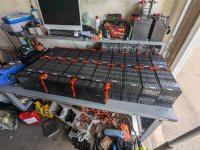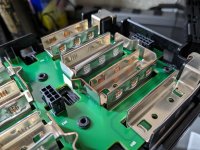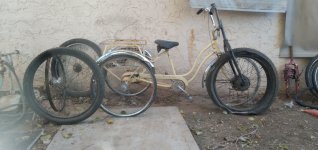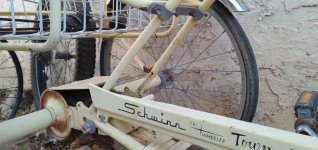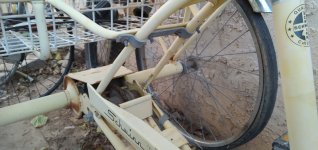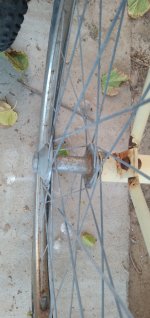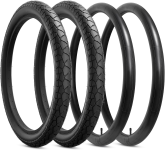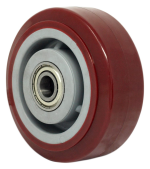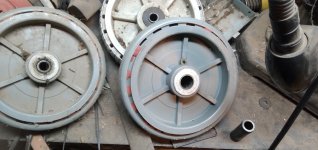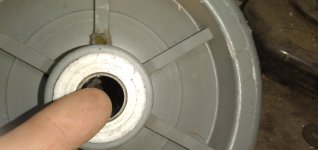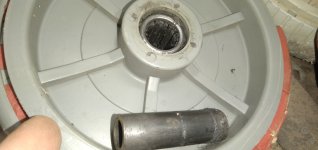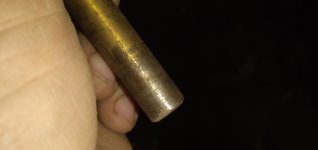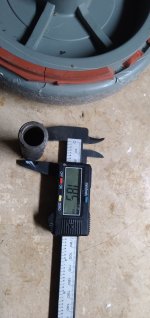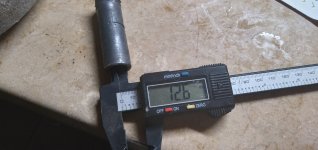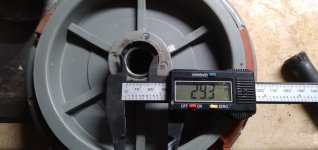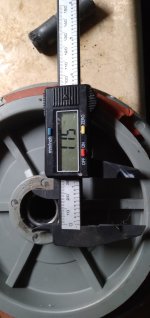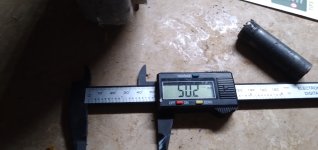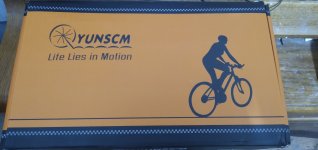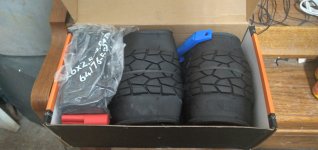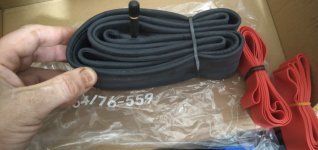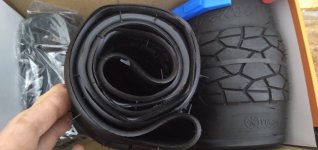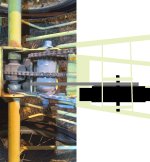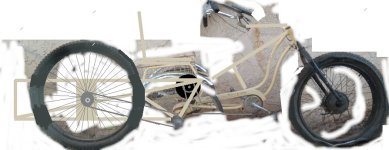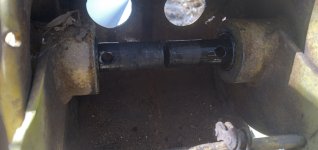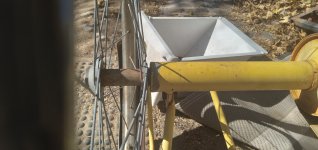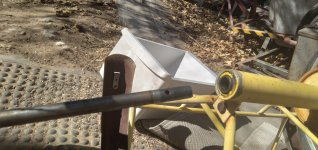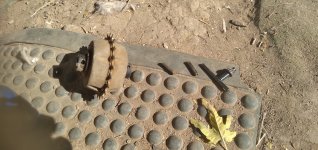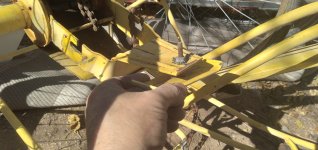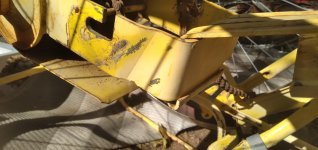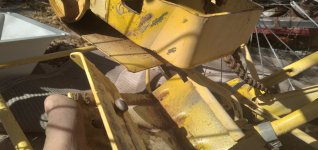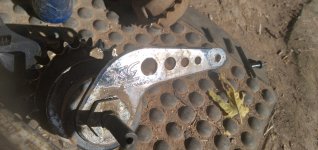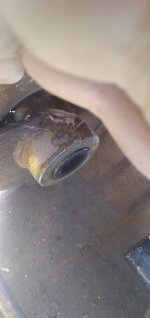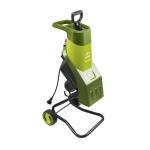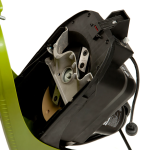From here:

 endless-sphere.com
endless-sphere.com
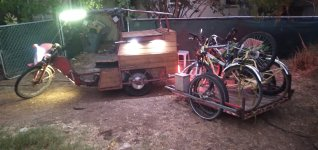
I got an old Schwinn Tri-Wheeler Town and Country (probably the 1971 or 75 or 78 model, based on info from bikehistory.org) from someone I knew from the Trashnothing/Freecycle list. Other than time-rotted tires (possibly original) and tubes, missing reflectors, faded paint, and a bit of rust here and there, and some other plastics that aged badly, it's in remarkably good shape.
 https://endless-sphere.com/sphere/attachments/20241103_193907-jpg.361493/ https://endless-sphere.com/sphere/attachments/20241103_193903-jpg.361492/ https://endless-sphere.com/sphere/attachments/20241103_193842-jpg.361491/ https://endless-sphere.com/sphere/attachments/20241103_193832-jpg.361490/ https://endless-sphere.com/sphere/attachments/20241103_193823-jpg.361489/
https://endless-sphere.com/sphere/attachments/20241103_193907-jpg.361493/ https://endless-sphere.com/sphere/attachments/20241103_193903-jpg.361492/ https://endless-sphere.com/sphere/attachments/20241103_193842-jpg.361491/ https://endless-sphere.com/sphere/attachments/20241103_193832-jpg.361490/ https://endless-sphere.com/sphere/attachments/20241103_193823-jpg.361489/
It also has a real differential in back, driven by a Shimano 3-speed hub 333 variation that Schwinn rebuilt the casing of to have an output gear on the casing isntead of spoke flanges, so the pedals drive both wheels. (the schwinn trike rear end I built SB Cruiser around only drives the left wheel, but uses normal wheels, appears intended to convert a schwinn 3-speed igh type bicycle into a trike).
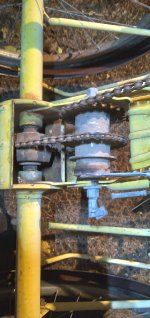
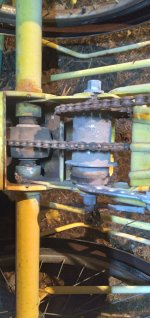

The coaster brake in the IGH operates on the rear wheels because of this, so it does have rear brakes as well as typical 70s type basic caliper on the front.
Steel rims, 28 spoke 24" wheels for skinny 1"-ish tires. Nothing left of any markings on the tires, so don't know for sure what width they used to be. The hubs are the type that mount to the transaxle, without bearings in the hubs (those are in the trike module axle housing)

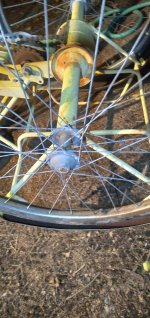
Ashtabula / one-piece cranks, singlespeed front directly to the IGH input. Chain appears original and has no problems turning, but could certainly use some oil.
The trike's rear wheel module has a center housing twice as wide as that on the SBC, with two finger holes to help with chain install/etc.
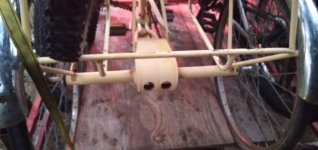
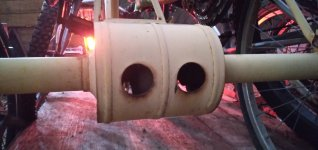
So I can easily put a middrive on it for primary drive, and a front hubmotor for redundancy and extra power if I need it for loads.
I considered leaving it nearly original, just replacing the saddle with a platform for one of the StadiumChair seats I use (probably the one I made long ago for the original version of the SB Cruiser; I think it's still in the shed), and replacing the rear carrier area with a deck platform for cargo, or more likely a cargo box built around the whole rear end. Then bolting some boxes to the sides under the seat (like I did with the original version of SBC). Possibly (probably) adding a bolt-on extension frame between the rear frame "trike" section and the front regular bike frame section, to give it the same wheelbase as the SBC (since I know that works) and a tiller for the handlebars (since I know that works for me), and to allow a longer / larger cargo area equivalent to the SBC.
But after working with some images in the computer, sketching stuff on them, I couldn't really find a way to make it usable for me without some fairly major changes, and building a whole rear subframe for the cargo area and "seatbox".
That's really the minimum job to make this usable for me, though it is much less work than the major construction job to basically build another SBC around the new trike's rear axle (which would be about the only part used from the frame in this case, kind of a waste). That gives me a spare trike for not nearly as much work that I can still use for many of the same things I use SBC for, and be able to use it for daily work commutes while I do other upgrades and fixes to SBC that have waited years to be done because there just wasn't time to do them and be certain of having it ready and available for work (presently SBC is my only transportation, and I dislike a lack of redundancy for critical things).
Also lets me experiment with the middrive option to a diff, which I wanted to try out on SBC MkII over here:

 endless-sphere.com
endless-sphere.com
Best guess is a few months of sparetime weekend work to do the minimal things, not including developing a reliable middrive out of either a hubmotor or one of my old brushed DC powerchair motors with gearbox (like I used on the original CrazyBike2). A front hubmotor (of which I have several laced in 26" wheels already) could be used until the MD was working.
I have lighting, controls, and other parts required that I had bought for the updated CrazyBike2 that was going to be the Cloudwalker Cargo Bike over here: Amberwolf's Cloudwalker Cargo Bike that I basically haven't touched since losing Kirin and then Yogi.
Battery can be one of the spares for SBC (presently mounted to the lawnmower; would then need to make new busbars for the other mower pack to make it 28s1p instead of 14s2p).
Controllers I have, probably use the generic ones I used to run SBC with before I got the Phaserunners for it. I think I have a spare CAv3 around here, and some magnet-ring cadence sensors (can't use a BB type like THUN or TDCM without converting the Ashtabula OPC this trike comes with into a threaded BB shell).

The SB Cruiser : Amberwolf's 2WD Heavy Cargo Trike & Dog Carrier
Another of the upper-rack LED turn/tail light strips has failed. previous failure here https://endless-sphere.com/sphere/threads/the-sb-cruiser-amberwolfs-2wd-heavy-cargo-trike-dog-carrier.67833/post-1746253 pic of that old one (present one is same kind, but replacements i have now are...
 endless-sphere.com
endless-sphere.com

I got an old Schwinn Tri-Wheeler Town and Country (probably the 1971 or 75 or 78 model, based on info from bikehistory.org) from someone I knew from the Trashnothing/Freecycle list. Other than time-rotted tires (possibly original) and tubes, missing reflectors, faded paint, and a bit of rust here and there, and some other plastics that aged badly, it's in remarkably good shape.
 https://endless-sphere.com/sphere/attachments/20241103_193907-jpg.361493/ https://endless-sphere.com/sphere/attachments/20241103_193903-jpg.361492/ https://endless-sphere.com/sphere/attachments/20241103_193842-jpg.361491/ https://endless-sphere.com/sphere/attachments/20241103_193832-jpg.361490/ https://endless-sphere.com/sphere/attachments/20241103_193823-jpg.361489/
https://endless-sphere.com/sphere/attachments/20241103_193907-jpg.361493/ https://endless-sphere.com/sphere/attachments/20241103_193903-jpg.361492/ https://endless-sphere.com/sphere/attachments/20241103_193842-jpg.361491/ https://endless-sphere.com/sphere/attachments/20241103_193832-jpg.361490/ https://endless-sphere.com/sphere/attachments/20241103_193823-jpg.361489/It also has a real differential in back, driven by a Shimano 3-speed hub 333 variation that Schwinn rebuilt the casing of to have an output gear on the casing isntead of spoke flanges, so the pedals drive both wheels. (the schwinn trike rear end I built SB Cruiser around only drives the left wheel, but uses normal wheels, appears intended to convert a schwinn 3-speed igh type bicycle into a trike).



The coaster brake in the IGH operates on the rear wheels because of this, so it does have rear brakes as well as typical 70s type basic caliper on the front.
Steel rims, 28 spoke 24" wheels for skinny 1"-ish tires. Nothing left of any markings on the tires, so don't know for sure what width they used to be. The hubs are the type that mount to the transaxle, without bearings in the hubs (those are in the trike module axle housing)


Ashtabula / one-piece cranks, singlespeed front directly to the IGH input. Chain appears original and has no problems turning, but could certainly use some oil.
The trike's rear wheel module has a center housing twice as wide as that on the SBC, with two finger holes to help with chain install/etc.


So I can easily put a middrive on it for primary drive, and a front hubmotor for redundancy and extra power if I need it for loads.
I considered leaving it nearly original, just replacing the saddle with a platform for one of the StadiumChair seats I use (probably the one I made long ago for the original version of the SB Cruiser; I think it's still in the shed), and replacing the rear carrier area with a deck platform for cargo, or more likely a cargo box built around the whole rear end. Then bolting some boxes to the sides under the seat (like I did with the original version of SBC). Possibly (probably) adding a bolt-on extension frame between the rear frame "trike" section and the front regular bike frame section, to give it the same wheelbase as the SBC (since I know that works) and a tiller for the handlebars (since I know that works for me), and to allow a longer / larger cargo area equivalent to the SBC.
But after working with some images in the computer, sketching stuff on them, I couldn't really find a way to make it usable for me without some fairly major changes, and building a whole rear subframe for the cargo area and "seatbox".
That's really the minimum job to make this usable for me, though it is much less work than the major construction job to basically build another SBC around the new trike's rear axle (which would be about the only part used from the frame in this case, kind of a waste). That gives me a spare trike for not nearly as much work that I can still use for many of the same things I use SBC for, and be able to use it for daily work commutes while I do other upgrades and fixes to SBC that have waited years to be done because there just wasn't time to do them and be certain of having it ready and available for work (presently SBC is my only transportation, and I dislike a lack of redundancy for critical things).
Also lets me experiment with the middrive option to a diff, which I wanted to try out on SBC MkII over here:

SB Cruiser Mk II design ponderings
This may not remain titled the same, but for now, SB Cruiser Mk II will do to get the idea across. :) So...I've been rebuilding the original SB Cruiser here: https://endless-sphere.com/forums/viewtopic.php?f=2&t=67833&start=350#p1227053 to fix a bunch of "little things" and make it more useful...
 endless-sphere.com
endless-sphere.com
Best guess is a few months of sparetime weekend work to do the minimal things, not including developing a reliable middrive out of either a hubmotor or one of my old brushed DC powerchair motors with gearbox (like I used on the original CrazyBike2). A front hubmotor (of which I have several laced in 26" wheels already) could be used until the MD was working.
I have lighting, controls, and other parts required that I had bought for the updated CrazyBike2 that was going to be the Cloudwalker Cargo Bike over here: Amberwolf's Cloudwalker Cargo Bike that I basically haven't touched since losing Kirin and then Yogi.
Battery can be one of the spares for SBC (presently mounted to the lawnmower; would then need to make new busbars for the other mower pack to make it 28s1p instead of 14s2p).
Controllers I have, probably use the generic ones I used to run SBC with before I got the Phaserunners for it. I think I have a spare CAv3 around here, and some magnet-ring cadence sensors (can't use a BB type like THUN or TDCM without converting the Ashtabula OPC this trike comes with into a threaded BB shell).



